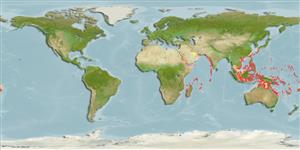Common names from other countries
Environment: milieu / climate zone / depth range / distribution range
Écologie
Récifal; profondeur 0 - 47 m (Ref. 8294). Tropical; 36°N - 34°S, 26°E - 137°W (Ref. 848)
Distribution
Pays | Zones FAO | Écosystèmes | Occurrences | Introductions
Indo-Pacific.
Length at first maturity / Taille / Poids / Âge
Maturity: Lm ? range ? - ? cm
Description synthétique
Morphologie
Colony: massive, either rounded or hillocky, sometimes over 1 m across. Corallites: rounded, with thick walls. Septa: straight, with exsert teeth. Color: dark in turbid environments, otherwise pale brown with brown or green oral discs (Ref. 848).
Maximum depth from Ref. 107542. Found in most reef environments (Ref. 848).
Life cycle and mating behavior
Maturité | Reproduction | Frai | Œufs | Fécondité | Larves
Hermaphroditic (Ref. 113712). Mature gametes are shed into the coelenteron and spawned through the mouth. Life cycle: The zygote develops into a planktonic planula larva. Metamorphosis begins with early morphogenesis of tentacles, septa and pharynx before larval settlement on the aboral end (Ref. 833).
Ross, M.A. and G. Hodgson. 1981. (Ref. 8294)
Statut dans la liste rouge de l'IUCN (Ref. 130435)
statut CITES (Ref. 108899)
Not Evaluated
Utilisations par l'homme
| FishSource |
Outils
Sources Internet
Estimates based on models
Preferred temperature
(Ref.
115969): 24.7 - 28.9, mean 27.6 (based on 422 cells).
Catégorie de prix
Unknown.
